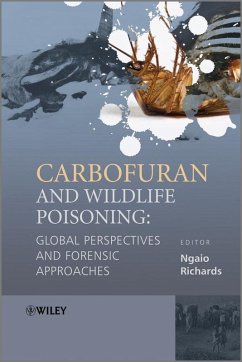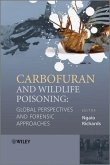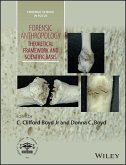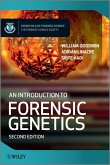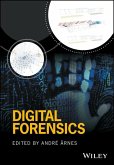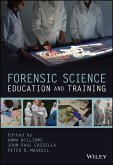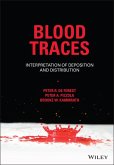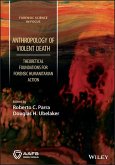Carbofuran and Wildlife Poisoning (eBook, PDF)
Global Perspectives and Forensic Approaches
Redaktion: Richards, Ngaio


Alle Infos zum eBook verschenken

Carbofuran and Wildlife Poisoning (eBook, PDF)
Global Perspectives and Forensic Approaches
Redaktion: Richards, Ngaio
- Format: PDF
- Merkliste
- Auf die Merkliste
- Bewerten Bewerten
- Teilen
- Produkt teilen
- Produkterinnerung
- Produkterinnerung

Hier können Sie sich einloggen

Bitte loggen Sie sich zunächst in Ihr Kundenkonto ein oder registrieren Sie sich bei bücher.de, um das eBook-Abo tolino select nutzen zu können.
This cutting-edge title is one of the first devoted entirely to the issue of carbofuran and wildlife mortality. It features a compilation of international contributions from policy-makers, researchers, conservationists and forensic practitioners and provides a summary of the history and mode of action of carbofuran, and its current global use. It covers wildlife mortality stemming from legal and illegal uses to this point, outlines wildlife rehabilitation, forensic and conservation approaches, and discuss global trends in responding to the wildlife mortality. The subject of carbofuran is very…mehr
- Geräte: PC
- mit Kopierschutz
- eBook Hilfe
- Größe: 14.01MB
![Carbofuran and Wildlife Poisoning (eBook, ePUB) Carbofuran and Wildlife Poisoning (eBook, ePUB)]() Carbofuran and Wildlife Poisoning (eBook, ePUB)125,99 €
Carbofuran and Wildlife Poisoning (eBook, ePUB)125,99 €![Forensic Anthropology (eBook, PDF) Forensic Anthropology (eBook, PDF)]() Forensic Anthropology (eBook, PDF)122,99 €
Forensic Anthropology (eBook, PDF)122,99 €![An Introduction to Forensic Genetics (eBook, PDF) An Introduction to Forensic Genetics (eBook, PDF)]() William GoodwinAn Introduction to Forensic Genetics (eBook, PDF)36,99 €
William GoodwinAn Introduction to Forensic Genetics (eBook, PDF)36,99 €![Digital Forensics (eBook, PDF) Digital Forensics (eBook, PDF)]() Digital Forensics (eBook, PDF)71,99 €
Digital Forensics (eBook, PDF)71,99 €![Forensic Science Education and Training (eBook, PDF) Forensic Science Education and Training (eBook, PDF)]() Forensic Science Education and Training (eBook, PDF)87,99 €
Forensic Science Education and Training (eBook, PDF)87,99 €![Blood Traces (eBook, PDF) Blood Traces (eBook, PDF)]() Peter R. de ForestBlood Traces (eBook, PDF)108,99 €
Peter R. de ForestBlood Traces (eBook, PDF)108,99 €![Anthropology of Violent Death (eBook, PDF) Anthropology of Violent Death (eBook, PDF)]() Anthropology of Violent Death (eBook, PDF)132,99 €
Anthropology of Violent Death (eBook, PDF)132,99 €-
-
-
Dieser Download kann aus rechtlichen Gründen nur mit Rechnungsadresse in A, B, BG, CY, CZ, D, DK, EW, E, FIN, F, GR, HR, H, IRL, I, LT, L, LR, M, NL, PL, P, R, S, SLO, SK ausgeliefert werden.
- Produktdetails
- Verlag: John Wiley & Sons
- Seitenzahl: 304
- Erscheinungstermin: 11. November 2011
- Englisch
- ISBN-13: 9781119998549
- Artikelnr.: 38267873
- Verlag: John Wiley & Sons
- Seitenzahl: 304
- Erscheinungstermin: 11. November 2011
- Englisch
- ISBN-13: 9781119998549
- Artikelnr.: 38267873
- Herstellerkennzeichnung Die Herstellerinformationen sind derzeit nicht verfügbar.
Acknowledgements xiii
Contributor biographies xv
1 An overview of the chemistry, manufacture, environmental fate and
detection of carbofuran 1
Stephen Donovan, Mark Taggart, Ngaio Richards
1.1 Introduction 1
1.2 The chemistry and mode of action of carbofuran 1
1.3 Manufacture and formulation of carbofuran 4
1.4 Carbofuran in the environment 5
1.4.1 Carbofuran precursors, metabolism and degradation products 6
1.5 Analytical methods used to detect carbofuran 8
1.5.1 Principles of chromatography 8
1.6 Conclusions 17
2 Carbofuran: Toxicity, diagnosing poisoning and rehabilitation of poisoned
birds 19
Pierre Mineau, Stuart Porter, Carol Uphoff Meteyer
2.1 Acute toxicity of carbofuran to birds and mammals 19
2.2 Exposure routes for the liquid formulation 22
2.3 Exposure routes for granular carbofuran formulations 23
2.3.1 Direct ingestion 23
2.3.2 Contaminated soil invertebrates 25
2.3.3 Contaminated soil/sediments 26
2.4 The time course of carbofuran intoxication 26
2.5 Physiological effects and signs of intoxication 27
2.6 Physical field evidence and necropsy findings in poisonings due to AChE
inhibiting compounds with special emphasis on carbofuran 28
2.7 Chemical and biochemical diagnosis of a carbofuran kill 31
2.8 Rehabilitation of poisoned wildlife 33
2.9 Conclusion 34
3 A chronicling of long-standing carbofuran use and its menace to wildlife
in Kenya 39
3.1 Introduction 39
Joseph O. Lalah, Peter O. Otieno, Ngaio Richards
3.2 Background on pesticide use and environmental monitoring in Kenya 43
Joseph O. Lalah and Peter O. Otieno
3.2.1 Furadan use in rice farming: how carbofuran first gained entry into
Kenya 43
3.2.2 Presence, persistence and degradation of carbofuran in Kenyan soils
46
3.2.3 General purchase and application of pesticides 48
3.2.4 General trends in use of pesticides in agricultural communities 49
3.3 Measuring the conservation threat that deliberate poisoning poses to
birds in Kenya: The case of pesticide hunting with Furadan in the Bunyala
Rice Irrigation Scheme 53
Martin Odino
3.3.1 Introduction 53
3.3.2 Methodology 54
3.3.3 Results of the study 57
3.3.4 Discussion 67
3.3.5 General conclusions 69
3.4 The role of carbofuran in the decline of lions and other carnivores in
Kenya 70
Laurence Frank, Alayne Cotterill, Stephanie Dolrenry, Leela Hazzah
3.4.1 Background information 70
3.4.2 Use of poison to kill carnivores in Kenya 71
3.4.3 Methods used to assess repercussions to scavenging mammals 71
3.4.4 Results 72
3.4.5 Discussion 74
3.5 Threats of secondary Furadan poisoning to scavengers, especially
vultures, in Kenya 74
Darcy Ogada
3.5.1 Misuse of Furadan to control farm pests 74
3.5.2 Effects of Furadan on vulture populations in Kenya 75
3.6 Forensic analysis of carbofuran in vultures and environmental samples
collected from Laikipia and Isiolo districts 77
Peter Otieno, Joseph O. Lalah, Munir Z. Virani
3.6.1 Survey result 78
3.6.2 Analysis of environmental sample 78
3.6.3 Conclusions of the study 81
3.7 Repercussions of pesticides (including carbofuran) on nontarget, benefi
cial insects and use of insects in forensic analyses in Kenya 81
Dino J. Martins
3.7.1 Studies on nontarget insects 81
3.7.2 Overview of insect diversity and abundance at a mammalian carcass:
the use of insects in upcoming forensic investigations in Kenya 82
3.8 Analytical, legal and regulatory mechanisms in Kenya 84
Joseph O. Lalah and Peter O. Otieno
3.8.1 Analytical methodology required and research capacity available in
Kenya 84
3.8.2 Legislation and regulation of pesticides in Kenya 85
3.9 General conclusions on carbofuran use, misuse and monitoring in Kenya
87
Joseph Lalah and Peter Otieno
4 Mitigating human-wildlife conflict and retaliatory poisonings in India to
preserve biodiversity and maintain sustainable livelihoods 99
Venkataramanan, R. and Sreekumar, C.
4.1 Introduction 99
4.2 Conservation measures and human-wildlife conflicts 100
4.3 Types of human-wildlife confl ict 101
4.4 Regulation and management of human-wildlife conflict 105
4.5 Use of carbofuran in India 109
4.6 Use of carbofuran in relation to other compounds 110
4.7 Diagnosing carbofuran poisoning in India 110
4.8 Forensic facilities and analyses in India 112
4.9 Case studies: use of carbofuran for poisoning in relation to other
compounds 113
4.9.1 Accidental exposure 113
4.9.2 Misuse of carbofuran 115
4.9.3 Deliberate poisoning using carbofuran and other compounds 116
4.10 Potential short and long-term solutions 121
4.10.1 Alternatives to carbofuran 121
4.10.2 Should carbofuran be banned in India? 122
4.11 Mitigation of human-wildlife conflicts 123
4.11.1 Habitat conservation 123
4.11.2 Community-based solutions 125
4.11.3 Compensation for loss of property 125
4.12 Conclusion 127
5 Regulation of carbofuran and its use to poison wildlife in the European
Union and the rest of Europe 132
5.1 Introduction 132
5.2 Intentional poisoning of piscivorous species and other wildlife with
carbofuran in the Czech Republic 135
Lukás Poledník, Katerina Poledníková, Jitka Vetrovcová, Václav Hlavác
5.2.1 Introduction 136
5.2.2 Poisoning of wildlife by carbofuran and its detection within the
Czech Republic 136
5.2.3 Legal and institutional framework against wildlife poisoning in the
Czech Republic 138
5.3 Persecution and poisoning of birds of prey in the Netherlands 139
Hugh Jansman, Peter van Tulden
5.3.1 Introduction 139
5.3.2 The scale of carbofuran use to poison wildlife, especially birds of
prey, in the Netherlands 140
5.3.3 Detection of carbofuran and other compounds in wildlife carcasses 142
5.3.4 Recommendations 142
5.4 Initiatives underway to protect wildlife from carbofuran poisoning in
Austria 144
Christian Pichler, Hermann Ammer
5.4.1 Introduction 143
5.4.2 Initiatives underway to generate awareness, about, and monitor
incidents of, carbofuran-related wildlife mortality in Austria 144
5.4.3 Toxicological analysis of wildlife carcasses in Austria 146
5.4.4 Conclusions 146
5.5 Use of specialised canine units to detect poisoned baits and recover
forensic evidence in Andalucía (Southern Spain) 147
Iñigo Fajardo, Antonio Ruiz, Irene Zorrilla, Antonio Valero, Isabel
Fernández, Ernesto Sáez, F.M. Molino, Jesús Olivares
5.5.1 Introduction 147
5.5.2 Integration of canine units in the anti-poisoning strategy of the
Government of Andalucía 149
5.5.3 Use of forensic procedures and techniques in the field and the
laboratory 151
5.5.4 Conclusions 155
5.6 Sociopolitical and rural influences on the management and monitoring of
carbofuran and its use to poison wildlife in Hungary 155
Péter Bedo"
5.6.1 Introduction 155
5.6.2 Incidents of carbofuran-related wildlife mortality in Hungary 156
5.6.3 Analysis of wildlife samples for poisons and other incidents of
poisoning in Hungary 156
5.6.4 Conclusions 157
5.7 Leisure-based human-wildlife conflicts arising from the introduction of
game species and repercussions to vultures across Croatia 157
Gordana Pavokovic
5.7.1 Introduction 157
5.7.2 Past registration and current use in Croatia 160
5.7.3 The use of carbofuran as a poison in relation to other compounds in
Croatia 160
5.7.4 Threats to biodiversity, livelihoods and tourism on the Croatian
islands 164
5.7.5 Nature protection and analytical capacity in Croatia 167
5.7.6 Recommended steps to address the current threat posed by carbofuran
168
6 Perspectives on wildlife poisoning by carbofuran in the United Kingdom
and Republic of Ireland - with a particular focus on Scotland 171
6.1 An overview of the registration and withdrawal of carbofuran products
171
6.2 An overview of human-wildlife conflicts in the UK and ROI 173
6.3 The effect of carbofuran poisoning and other illegal persecution
methods on raptor populations in Scotland 174
Ruth E. Tingay
6.4 A landowner's perspective on wildlife poisoning in Scotland 178
Douglas McAdam
6.5 Monitoring carbofuran abuse in Scotland 181
Michael J. Taylor
6.5.1 Introduction 181
6.5.2 The impact of carbofuran abuse in Scotland 182
6.5.3 Analytical methodology and recent developments 183
6.5.4 Conclusion and discussion 185
7 A Latin American perspective: the environmental impact of farming wheat
and rice treated with carbofuran and Rhodamine B on Brazilian wild birds
189
Alexandre de Almeida and Álvaro Fernando de Almeida
7.1 Introduction 189
7.2 Materials and methods 192
7.3 Results and discussion: biological aspects of the environmental impact
caused by carbofuran and Rhodamine B on Brazilian wild birds 195
7.3.1 Alternatives and mitigation 200
7.3.2 Avian mortality and some aspects that influence this estimate 201
8 Impacts of carbofuran on birds in Canada and the United States 208
Pierre Mineau, Linda Lyon, Stella McMillin
8.1 Introduction and short registration history of carbofuran in North
America 208
8.2 Impacts from the sandcore (silica) granular formulations 210
8.2.1 Supervised field trials and surveillance exercises 210
8.2.2 Reported incidents where the product was applied according to label
directions 214
8.3 Impacts from the corncob granular formulation 222
8.3.1 Supervised field trials 223
8.3.2 Reported incidents 224
8.4 Impacts from the flowable (liquid) formulation 225
8.4.1 Industry-supervised field trials 227
8.4.2 Field studies of carbofuran used as a grasshopper insecticide 230
8.4.3 Monitoring programmes in US cotton 234
8.4.4 Incidents 235
8.5 Evidence for secondary poisoning impacts with any formulation type 241
8.6 Impacts resulting from abuse cases regardless of formulation 242
8.7 Conclusions 243
9 Conclusions, recommendations and the way forward 251
Ngaio Richards
9.1 Wildlife mortality stemming from intentional misuse and legal/labelled
use of carbofuran 251
9.2 Overall recommendations and the way forward 253
9.2.1 Address and mitigate the root causes of human-wildlife conflict 253
9.2.2 Increase grassroots educational initiatives 254
9.2.3 Enhance analytical capacity and increase sampling, testing and
monitoring efforts 254
9.2.4 Conduct studies in critical but currently under-represented subjects
255
9.2.5 Coordinate international monitoring and conservation efforts 256
9.2.6 Address outstanding policy and accountability issues 256
Appendix 260
References 261
Index 263
Acknowledgements xiii
Contributor biographies xv
1 An overview of the chemistry, manufacture, environmental fate and
detection of carbofuran 1
Stephen Donovan, Mark Taggart, Ngaio Richards
1.1 Introduction 1
1.2 The chemistry and mode of action of carbofuran 1
1.3 Manufacture and formulation of carbofuran 4
1.4 Carbofuran in the environment 5
1.4.1 Carbofuran precursors, metabolism and degradation products 6
1.5 Analytical methods used to detect carbofuran 8
1.5.1 Principles of chromatography 8
1.6 Conclusions 17
2 Carbofuran: Toxicity, diagnosing poisoning and rehabilitation of poisoned
birds 19
Pierre Mineau, Stuart Porter, Carol Uphoff Meteyer
2.1 Acute toxicity of carbofuran to birds and mammals 19
2.2 Exposure routes for the liquid formulation 22
2.3 Exposure routes for granular carbofuran formulations 23
2.3.1 Direct ingestion 23
2.3.2 Contaminated soil invertebrates 25
2.3.3 Contaminated soil/sediments 26
2.4 The time course of carbofuran intoxication 26
2.5 Physiological effects and signs of intoxication 27
2.6 Physical field evidence and necropsy findings in poisonings due to AChE
inhibiting compounds with special emphasis on carbofuran 28
2.7 Chemical and biochemical diagnosis of a carbofuran kill 31
2.8 Rehabilitation of poisoned wildlife 33
2.9 Conclusion 34
3 A chronicling of long-standing carbofuran use and its menace to wildlife
in Kenya 39
3.1 Introduction 39
Joseph O. Lalah, Peter O. Otieno, Ngaio Richards
3.2 Background on pesticide use and environmental monitoring in Kenya 43
Joseph O. Lalah and Peter O. Otieno
3.2.1 Furadan use in rice farming: how carbofuran first gained entry into
Kenya 43
3.2.2 Presence, persistence and degradation of carbofuran in Kenyan soils
46
3.2.3 General purchase and application of pesticides 48
3.2.4 General trends in use of pesticides in agricultural communities 49
3.3 Measuring the conservation threat that deliberate poisoning poses to
birds in Kenya: The case of pesticide hunting with Furadan in the Bunyala
Rice Irrigation Scheme 53
Martin Odino
3.3.1 Introduction 53
3.3.2 Methodology 54
3.3.3 Results of the study 57
3.3.4 Discussion 67
3.3.5 General conclusions 69
3.4 The role of carbofuran in the decline of lions and other carnivores in
Kenya 70
Laurence Frank, Alayne Cotterill, Stephanie Dolrenry, Leela Hazzah
3.4.1 Background information 70
3.4.2 Use of poison to kill carnivores in Kenya 71
3.4.3 Methods used to assess repercussions to scavenging mammals 71
3.4.4 Results 72
3.4.5 Discussion 74
3.5 Threats of secondary Furadan poisoning to scavengers, especially
vultures, in Kenya 74
Darcy Ogada
3.5.1 Misuse of Furadan to control farm pests 74
3.5.2 Effects of Furadan on vulture populations in Kenya 75
3.6 Forensic analysis of carbofuran in vultures and environmental samples
collected from Laikipia and Isiolo districts 77
Peter Otieno, Joseph O. Lalah, Munir Z. Virani
3.6.1 Survey result 78
3.6.2 Analysis of environmental sample 78
3.6.3 Conclusions of the study 81
3.7 Repercussions of pesticides (including carbofuran) on nontarget, benefi
cial insects and use of insects in forensic analyses in Kenya 81
Dino J. Martins
3.7.1 Studies on nontarget insects 81
3.7.2 Overview of insect diversity and abundance at a mammalian carcass:
the use of insects in upcoming forensic investigations in Kenya 82
3.8 Analytical, legal and regulatory mechanisms in Kenya 84
Joseph O. Lalah and Peter O. Otieno
3.8.1 Analytical methodology required and research capacity available in
Kenya 84
3.8.2 Legislation and regulation of pesticides in Kenya 85
3.9 General conclusions on carbofuran use, misuse and monitoring in Kenya
87
Joseph Lalah and Peter Otieno
4 Mitigating human-wildlife conflict and retaliatory poisonings in India to
preserve biodiversity and maintain sustainable livelihoods 99
Venkataramanan, R. and Sreekumar, C.
4.1 Introduction 99
4.2 Conservation measures and human-wildlife conflicts 100
4.3 Types of human-wildlife confl ict 101
4.4 Regulation and management of human-wildlife conflict 105
4.5 Use of carbofuran in India 109
4.6 Use of carbofuran in relation to other compounds 110
4.7 Diagnosing carbofuran poisoning in India 110
4.8 Forensic facilities and analyses in India 112
4.9 Case studies: use of carbofuran for poisoning in relation to other
compounds 113
4.9.1 Accidental exposure 113
4.9.2 Misuse of carbofuran 115
4.9.3 Deliberate poisoning using carbofuran and other compounds 116
4.10 Potential short and long-term solutions 121
4.10.1 Alternatives to carbofuran 121
4.10.2 Should carbofuran be banned in India? 122
4.11 Mitigation of human-wildlife conflicts 123
4.11.1 Habitat conservation 123
4.11.2 Community-based solutions 125
4.11.3 Compensation for loss of property 125
4.12 Conclusion 127
5 Regulation of carbofuran and its use to poison wildlife in the European
Union and the rest of Europe 132
5.1 Introduction 132
5.2 Intentional poisoning of piscivorous species and other wildlife with
carbofuran in the Czech Republic 135
Lukás Poledník, Katerina Poledníková, Jitka Vetrovcová, Václav Hlavác
5.2.1 Introduction 136
5.2.2 Poisoning of wildlife by carbofuran and its detection within the
Czech Republic 136
5.2.3 Legal and institutional framework against wildlife poisoning in the
Czech Republic 138
5.3 Persecution and poisoning of birds of prey in the Netherlands 139
Hugh Jansman, Peter van Tulden
5.3.1 Introduction 139
5.3.2 The scale of carbofuran use to poison wildlife, especially birds of
prey, in the Netherlands 140
5.3.3 Detection of carbofuran and other compounds in wildlife carcasses 142
5.3.4 Recommendations 142
5.4 Initiatives underway to protect wildlife from carbofuran poisoning in
Austria 144
Christian Pichler, Hermann Ammer
5.4.1 Introduction 143
5.4.2 Initiatives underway to generate awareness, about, and monitor
incidents of, carbofuran-related wildlife mortality in Austria 144
5.4.3 Toxicological analysis of wildlife carcasses in Austria 146
5.4.4 Conclusions 146
5.5 Use of specialised canine units to detect poisoned baits and recover
forensic evidence in Andalucía (Southern Spain) 147
Iñigo Fajardo, Antonio Ruiz, Irene Zorrilla, Antonio Valero, Isabel
Fernández, Ernesto Sáez, F.M. Molino, Jesús Olivares
5.5.1 Introduction 147
5.5.2 Integration of canine units in the anti-poisoning strategy of the
Government of Andalucía 149
5.5.3 Use of forensic procedures and techniques in the field and the
laboratory 151
5.5.4 Conclusions 155
5.6 Sociopolitical and rural influences on the management and monitoring of
carbofuran and its use to poison wildlife in Hungary 155
Péter Bedo"
5.6.1 Introduction 155
5.6.2 Incidents of carbofuran-related wildlife mortality in Hungary 156
5.6.3 Analysis of wildlife samples for poisons and other incidents of
poisoning in Hungary 156
5.6.4 Conclusions 157
5.7 Leisure-based human-wildlife conflicts arising from the introduction of
game species and repercussions to vultures across Croatia 157
Gordana Pavokovic
5.7.1 Introduction 157
5.7.2 Past registration and current use in Croatia 160
5.7.3 The use of carbofuran as a poison in relation to other compounds in
Croatia 160
5.7.4 Threats to biodiversity, livelihoods and tourism on the Croatian
islands 164
5.7.5 Nature protection and analytical capacity in Croatia 167
5.7.6 Recommended steps to address the current threat posed by carbofuran
168
6 Perspectives on wildlife poisoning by carbofuran in the United Kingdom
and Republic of Ireland - with a particular focus on Scotland 171
6.1 An overview of the registration and withdrawal of carbofuran products
171
6.2 An overview of human-wildlife conflicts in the UK and ROI 173
6.3 The effect of carbofuran poisoning and other illegal persecution
methods on raptor populations in Scotland 174
Ruth E. Tingay
6.4 A landowner's perspective on wildlife poisoning in Scotland 178
Douglas McAdam
6.5 Monitoring carbofuran abuse in Scotland 181
Michael J. Taylor
6.5.1 Introduction 181
6.5.2 The impact of carbofuran abuse in Scotland 182
6.5.3 Analytical methodology and recent developments 183
6.5.4 Conclusion and discussion 185
7 A Latin American perspective: the environmental impact of farming wheat
and rice treated with carbofuran and Rhodamine B on Brazilian wild birds
189
Alexandre de Almeida and Álvaro Fernando de Almeida
7.1 Introduction 189
7.2 Materials and methods 192
7.3 Results and discussion: biological aspects of the environmental impact
caused by carbofuran and Rhodamine B on Brazilian wild birds 195
7.3.1 Alternatives and mitigation 200
7.3.2 Avian mortality and some aspects that influence this estimate 201
8 Impacts of carbofuran on birds in Canada and the United States 208
Pierre Mineau, Linda Lyon, Stella McMillin
8.1 Introduction and short registration history of carbofuran in North
America 208
8.2 Impacts from the sandcore (silica) granular formulations 210
8.2.1 Supervised field trials and surveillance exercises 210
8.2.2 Reported incidents where the product was applied according to label
directions 214
8.3 Impacts from the corncob granular formulation 222
8.3.1 Supervised field trials 223
8.3.2 Reported incidents 224
8.4 Impacts from the flowable (liquid) formulation 225
8.4.1 Industry-supervised field trials 227
8.4.2 Field studies of carbofuran used as a grasshopper insecticide 230
8.4.3 Monitoring programmes in US cotton 234
8.4.4 Incidents 235
8.5 Evidence for secondary poisoning impacts with any formulation type 241
8.6 Impacts resulting from abuse cases regardless of formulation 242
8.7 Conclusions 243
9 Conclusions, recommendations and the way forward 251
Ngaio Richards
9.1 Wildlife mortality stemming from intentional misuse and legal/labelled
use of carbofuran 251
9.2 Overall recommendations and the way forward 253
9.2.1 Address and mitigate the root causes of human-wildlife conflict 253
9.2.2 Increase grassroots educational initiatives 254
9.2.3 Enhance analytical capacity and increase sampling, testing and
monitoring efforts 254
9.2.4 Conduct studies in critical but currently under-represented subjects
255
9.2.5 Coordinate international monitoring and conservation efforts 256
9.2.6 Address outstanding policy and accountability issues 256
Appendix 260
References 261
Index 263
